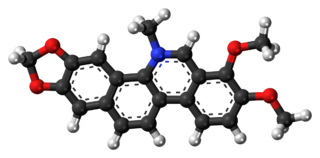
Gentamicin is an antibiotic used to treat several types of bacterial infections. This may include bone infections, endocarditis, pelvic inflammatory disease, meningitis, pneumonia, urinary tract infections, and sepsis among others. It is not effective for gonorrhea or chlamydia infections. It can be given intravenously, by intramuscular injection, or topically. Topical formulations may be used in burns or for infections of the outside of the eye. It is often only used for two days until bacterial cultures determine what specific antibiotics the infection is sensitive to. The dose required should be monitored by blood testing.

Polyhydroxybutyrate (PHB) is a polyhydroxyalkanoate (PHA), a polymer belonging to the polyesters class that are of interest as bio-derived and biodegradable plastics. The poly-3-hydroxybutyrate (P3HB) form of PHB is probably the most common type of polyhydroxyalkanoate, but other polymers of this class are produced by a variety of organisms: these include poly-4-hydroxybutyrate (P4HB), polyhydroxyvalerate (PHV), polyhydroxyhexanoate (PHH), polyhydroxyoctanoate (PHO) and their copolymers.
Production of antibiotics is a naturally occurring event, that thanks to advances in science can now be replicated and improved upon in laboratory settings. Due to the discovery of penicillin by Alexander Flemming, and the efforts of Florey and Chain in 1938, large-scale, pharmaceutical production of antibiotics has been made possible. As with the initial discovery of penicillin, most antibiotics have been discovered as a result of happenstance. Antibiotic production can be grouped into three methods: natural fermentation, semi-synthetic, and synthetic. As more and more bacteria continue to develop resistance to currently produced antibiotics, research and development of new antibiotics continues to be important. In addition to research and development into the production of new antibiotics, repackaging delivery systems is important to improving efficacy of the antibiotics that are currently produced. Improvements to this field have seen the ability to add antibiotics directly into implanted devices, aerosolization of antibiotics for direct delivery, and combination of antibiotics with non antibiotics to improve outcomes. The increase of antibiotic resistant strains of pathogenic bacteria has led to an increased urgency for the funding of research and development of antibiotics and a desire for production of new and better acting antibiotics.

Chelerythrine is a benzophenanthridine alkaloid present in the plant Chelidonium majus. It is a potent, selective, and cell-permeable protein kinase C inhibitor in vitro. And an efficacious antagonist of G-protein-coupled CB1 receptors. This molecule also exhibits anticancer qualities and it has served as a base for many potential novel drugs against cancer. Structurally, this molecule has two distinct conformations, one being a positively charged iminium form, and the other being an uncharged form, a pseudo-base.

Emodin (6-methyl-1,3,8-trihydroxyanthraquinone) is a chemical compound, of the anthraquinone family, that can be isolated from rhubarb, buckthorn, and Japanese knotweed. Emodin is particularly abundant in the roots of the Chinese rhubarb, knotweed and knotgrass as well as Hawaii ‘au‘auko‘i cassia seeds or coffee weed. It is specifically isolated from Rheum palmatum L. It is also produced by many species of fungi, including members of the genera Aspergillus, Pyrenochaeta, and Pestalotiopsis, inter alia. The common name is derived from Rheum emodi, a taxonomic synonym of Rheum australe, and synonyms include emodol, frangula emodin, rheum emodin, 3-methyl-1,6,8-trihydroxyanthraquinone, Schuttgelb, and Persian Berry Lake.
Streptomyces alboflavus is a bacterium species from the genus of Streptomyces which produces oxytetracycline, tetracycline and desertomycin A.
Streptomyces albogriseolus is a bacterium species from the genus of Streptomyces which has been isolated from soil. Streptomyces albogriseolus produces neomycin B and neomycin C.
Streptomyces ambofaciens is a bacterium species from the genus Streptomyces which has been isolated from soil from France. Streptomyces ambofaciens produces ambobactin, foromacidin A, foromacidin B, foromacidin C, 18-deoxospiramicin I, 17-methylenespiramycin I and congocidin.
Streptomyces candidus is a bacterium species from the genus of Streptomyces which has been isolated from soil in Russia. Streptomyces candidus produces lemonomycin, enterocin, pyrazofurin and avoparcin.
Streptomyces griseoaurantiacus is a thermotolerant bacterium species from the genus of Streptomyces which was isolated from marine sediment. Streptomyces griseoaurantiacus produces the antibiotics manumycin, diperamycin and chinikomycin, and griseolic acid.
Streptomyces griseofuscus is a bacterium species from the genus of Streptomyces which has been isolated from soil in Japan. Streptomyces griseofuscus produces azinomycin A, azinomycin B, bundlin A, bundlin B, moldicidin A, physostigmine, fungichromin and pentamycin.
Streptomyces lusitanus is a bacterium species from the genus of Streptomyces which has been isolated from soil. Streptomyces lusitanus produces 7-chlortetracycline, naphthyridinomycin, cyanocycline B, N-desmethylnaphthyridinomycin and tetracycline.
Streptomyces microflavus is a bacterium species from the genus of Streptomyces which has been isolated from soil. Streptomyces microflavus produces nemadectin, fattiviracin A1, milbemycin and deoxyuridines. Streptomyces microflavus also produces the ionophore valinomycin. Streptomyces microflavus is also known to cause potato common scab disease in Korea.
Streptomyces mobaraensis is a spore forming bacterium species from the genus of Streptomyces. Streptomyces mobaraensis produces bleomycin, detoxin, piericidin A, piericidin B, reticulol and transglutaminase. Streptomyces mobaraensis is used in the food industry to produce transglutaminase to texture meat and fish products.
Streptomyces nitrosporeus is a bacterium species from the genus of Streptomyces which has been isolated from garden soil in Japan. Streptomyces nitrosporeus produces Benzastatin E, Benzastatin F, Benzastatin G Nitrosporeusine A and Nitrosporeusine B and the antibiotics nitrosporin and virantomycin and the inhibitor of angiotensin-converting enzyme foroxymithine. Streptomyces nitrosporeus can degrade cellulose.
Streptomyces lushanensis is a bacterium species from the genus of Streptomyces which has been isolated from soil from the Lushan Mountain in China. Streptomyces lushanensis has antibacterial activity.
Streptomyces lydicamycinicus is a bacterium species from the genus of Streptomyces. Streptomyces lydicamycinicus produces the antibiotic lydicamycin.

N-Acetyltryptamine is an organic compound with the molecular formula C12H14N2O. It is a partial agonist for the melatonin receptors. N-Acetyltryptamine is produced by Streptomyces djakartensis and other Streptomyces and Fusarium species.

Ambobactin is an depsipeptide antibiotic with the molecular formula C59H77N13O19. Ambobactin is produced by the bacterium Streptomyces ambofaciens.

Praseodymium(V) oxide nitride is a compound of praseodymium in the oxidation state of +5 with the formula PrNO, which was first reported in 2000, however, the compound wasn't verified to have an oxidation state of +5 until 2017. This compound is produced by the reaction of praseodymium metal and nitric oxide in 4K and solid neon. The crystal structure is linear with the praseodymium forming a triple bond with the nitrogen and a double bond with the oxygen. Calculation shows a significant level of f-orbital covalence of Pr-X bonds.






